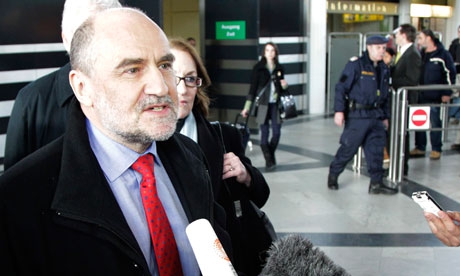 This article was written by Julian Borger�for the Guardian on�Friday November 23, 2012. Julian Borger�is the Guardian's diplomatic editor. He was previously a correspondent in the US, the Middle East, eastern Europe and the Balkans.
This article was written by Julian Borger�for the Guardian on�Friday November 23, 2012. Julian Borger�is the Guardian's diplomatic editor. He was previously a correspondent in the US, the Middle East, eastern Europe and the Balkans.IAEA inspectors say Iran may soon speed up its uranium enrichment, making the search for a deal even more urgent
Having delivered its�latest quarterly report�on Iran's nuclear programme to its board, the nuclear safeguards department of the�International Atomic Energy Agency (IAEA)�gave a technical briefing on Wednesday to an audience of ambassadors in Vienna about the same material but with some pictures to make the whole thing clearer. At such briefings, ambassadors can also ask questions to sound out the head of safeguards, Herman Nackaerts, on his impressions.
On this occasion, the main message western ambassadors came away with was that Iran appears to be just days away from starting feeding uranium hexafluoride gas into four new cascades of centrifuges at its underground enrichment site at Fordow. Those cascades, of 174 centrifuges each, are being vacuum tested which is usually the last step before piping in the uranium gas. The impression given at the technical briefing was that these new cascades would almost certainly be producing 20%-enriched uranium, which is the main proliferation concern and the leading source of international tension over the Iranian programme.
For the past six months Iran has been producing 20% uranium at the rate of 14 to 15 kg a month. It now has a stockpile of about 135 kg, while Israel has declared that 240 kg, enough to make a single warhead if further enriched, is its red line, implying it would take military action to stop Iran reaching that point. If the four new cascades work properly and starting spinning uranium, the production rate would go up to 25 kg a month, so the red line would be breached in about four months, rather than seven.
In the first half of the year, Iran had been diverting some of its 20% production to making reactor fuel and so taking it out of the stockpile. By August, it had taken about 96 kg for that purpose, thereby putting off the moment it had enough to theoretically make a bomb. Israeli officials claim it was for this reason that they did not take action this year.
The bad news is that in the past three months, Iran did not divert any of its 20% uranium for fuel, so the stockpile kept rising. The slightly good news from Wednesday's technical breaking is that this pause did appear to be for purely technical reasons. There seems to be a fault in the fuel fabrication plant in Isfahan which turns uranium powdered fuel into pellets, so there is a backlog. If this problem can be fixed, 20% uranium would once again be taken to Isfahan to make fuel, and the growth in the stockpile would be slowed. But it would not be stopped. As the red line starts to looms large, western capitals are likely to ask the IAEA to start briefing them on the progress of the Iran programme on a more frequent basis than just once every three months.
The bottom line is that the window for diplomacy that opened with the US election is now closing again at an accelerating rate. All sides had been waiting for the November 6 vote as that was to determine the course of US policy. Barack Obama's administration was known to be resolved to give talks another go, but was not going to lay its cards on the table during the election campaign, for fear of appearing 'soft' on Iran.
On the same day as the Nackaerts briefing in Vienna, senior diplomats from the six major powers conducting talks with Iran met for the first time since the election in Brussels to discuss what their new negotiating position might be. However, by all accounts, there was dramatic new blueprint put on the table.
The six foreign ministry political directors generally agreed that some form of sanctions relief would have to be put more clearly on the table to help draw Iran into negotiating away its 20% uranium, but there were no specifics. The six declared, through their convenor, the EU foreign policy chief, Cathy Ashton, that they are ready to meet their Iranian counterpart, Saeed Jalili to resume high-level talks as soon as possible. But that meeting, if it happens, is now not going to be in November as had been planned. It will slip into December, or possibly even January.
By that time, the Israeli elections will be imminent, and if the IAEA inspectors are right, the rate of Iranian enrichment will have been stepped up. As always, the centrifuges are working far faster than the diplomacy.
The Iran Project is not responsible for the content of quoted articles.











